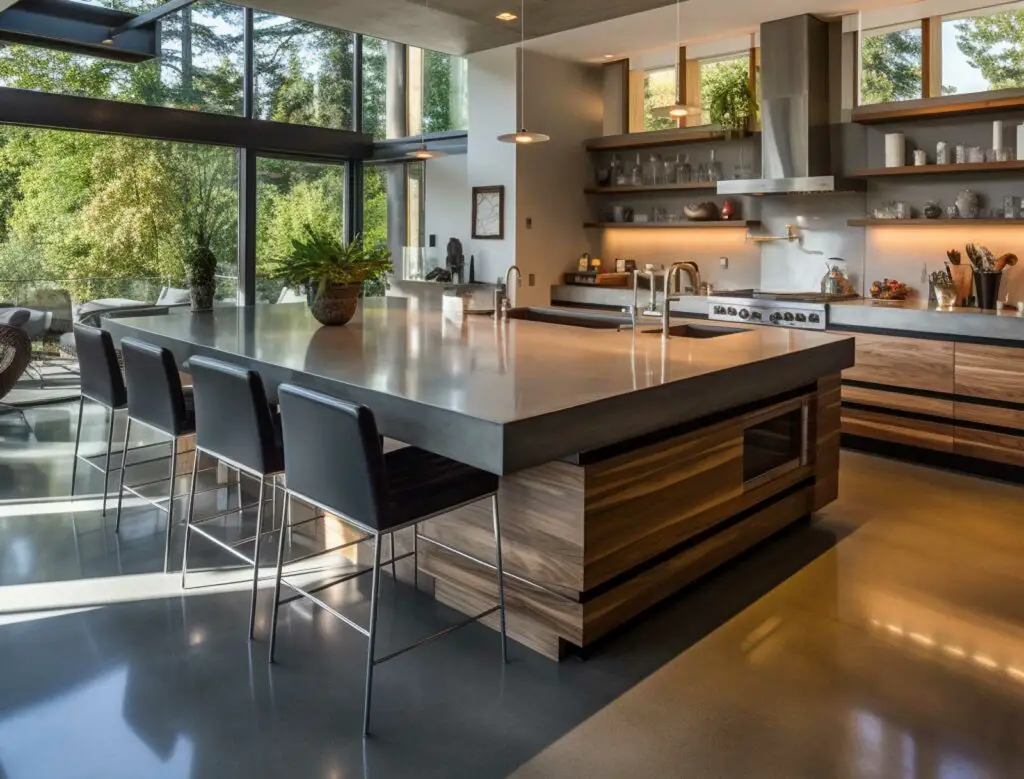When it comes to home renovations and DIY projects, sometimes it’s hard to tell how much you’re going concrete you’re going to need for your project.
From building a backyard fire pit to creating a unique garden bench, these projects will test your skills and creativity.
So as you’re sitting there thinking through all the various projects you want to do around your house (or looking through your honey-do list) it’s always best to measure twice and cut once, proverbially speaking.
Do you need a full pallet-load of concrete?
Should you use 80 pound bags?
What’s involved in doing these kinds of projects?
I going to give you an idea of what’s involved (from my own personal experience) and what you’re going to need in terms of concrete for the projects you’ve got in your future.
Understanding Concrete and Its Uses
You may think of concrete as just a boring gray slab, but it’s actually an incredibly versatile material that can be used in a variety of projects. In fact, it’s the most commonly used building material in the world!
Concrete is made up of a mixture of cement, water, and aggregates like sand and gravel. (Teaser) The cement acts as a binding agent, holding everything together and giving the concrete its strength.
One of the great things about concrete is that it can be used for both functional and decorative purposes.
It’s commonly used in construction projects like building foundations, walls, and sidewalks, but it can also be used to create decorative features like stamped concrete patios or countertops. (Teaser)
Stamped concrete is a popular decorative option that can mimic the look of other materials like brick or stone. By stamping a pattern into the wet concrete and adding color, you can create a unique and eye-catching feature for your home or business.
In my experience, stamped concrete is a great way to add some personality to your outdoor space. (Personal anecdote)
Another popular use for concrete is in creating countertops.
Concrete countertops are durable, customizable, and can be made to fit any space. (Teaser) They can also be stained or dyed to create a variety of different looks.
If you’re looking for a more industrial or modern look, concrete is a great option for flooring.
It’s durable, easy to clean, and can be polished to a high shine. (Teaser) Plus, it’s a great option for spaces with radiant heating, as it will hold and radiate heat well.
Overall, concrete is an incredibly versatile material that can be used in a variety of projects.
From functional construction projects to decorative features like stamped concrete, there are endless possibilities for using this common building material. (Teaser)
Choosing the Right Concrete for Your Project
Are you planning to start a project that requires a pallet load of concrete? Choosing the right type of concrete mix can make all the difference in the success of your project. In this section, we will cover the different factors you need to consider when selecting the right concrete mix for your project.
Bag Size Matters
Before you start purchasing concrete, you need to determine the amount of concrete you need for your project. The easiest way to do this is to calculate the cubic footage of the area you need to cover. Once you have the cubic footage, you can determine the number of bags of concrete you need. Keep in mind that the size of the bag matters. Most bags of concrete come in 60 or 80-pound bags, but some specialty mixes come in 40-pound bags.
Specialty Mixes for Specific Needs
If you have a specific need for your project, you may need to choose a specialty mix. For example, if you are working on a project that requires a high-strength concrete mix, you may want to consider Quikrete’s High Strength Concrete Mix. If you need a fast-setting concrete mix, you may want to consider Sakrete’s Fast-Setting Concrete Mix. Whatever your project requires, there is likely a specialty mix available to meet your needs.
Quikrete vs. Sakrete: Which Brand is Best?
When it comes to choosing a brand of concrete, two of the most popular brands are Quikrete and Sakrete. Both brands offer a wide variety of concrete mixes, but which one is right for your project? In our experience, both brands offer quality products, so it comes down to personal preference. Some people prefer Quikrete because they offer a larger variety of mixes, while others prefer Sakrete because they offer a wider range of bag sizes.
In our experience, we found that Quikrete’s products are more widely available in home improvement stores, but Sakrete’s products are more commonly used by professional contractors. Ultimately, the brand you choose will depend on your personal preference and the availability of the product in your area.
In conclusion, choosing the right concrete mix for your project is essential to ensure its success. Consider the amount of concrete you need, any specialty requirements, and the brand of concrete you prefer. By taking the time to choose the right concrete mix, you can ensure that your project is completed successfully and to your satisfaction.
Estimating Concrete Needs
Are you planning a big project that requires a pallet load of concrete? One of the most important steps in any concrete project is estimating the amount of concrete you will need. Estimating accurately can help you avoid costly mistakes and delays. Here’s how to estimate your concrete needs.
Using the Length x Width x Depth Formula
The most common method for estimating concrete needs is to use the length x width x depth formula. This formula helps you calculate the cubic feet of concrete you will need. Once you have the cubic feet, you can convert it to cubic yards, which is the standard unit of measurement for concrete.
To use this formula, measure the length, width, and depth of the area you will be filling with concrete. Multiply the length by the width, then by the depth. This will give you the cubic feet of concrete you need. Divide this number by 27 to get the cubic yards.
Using a Concrete Calculator
If you don’t want to do the math yourself, you can use a concrete calculator. These calculators are available online and can help you estimate the amount of concrete you need based on the dimensions of your project. Simply enter the length, width, and depth of the area you will be filling, and the calculator will do the rest.
One great thing about using a concrete calculator is that it can help you estimate the specific amount of concrete you need. This can be very helpful if you are working on a project with unique dimensions or irregular shapes.
Factors That Affect Concrete Needs
It’s important to note that there are several factors that can affect your concrete needs. For example, if you are working on a project with sloped surfaces, you may need more concrete to ensure proper coverage. Additionally, if you are working in hot or dry conditions, you may need to add more water to the mix, which can affect the amount of concrete you need.
In my experience, it’s always a good idea to order a little bit more concrete than you think you will need. This can help you avoid running out of concrete mid-project and can also help you account for any unexpected factors that may increase your concrete needs.
Estimating your concrete needs can seem like a daunting task, but with the right tools and a little bit of knowledge, it’s actually quite simple. Whether you use the length x width x depth formula or a concrete calculator, taking the time to estimate your needs accurately can help you save time, money, and hassle in the long run.
Purchasing and Transporting Concrete
Are you planning a construction project that requires a pallet load of concrete? If so, you’ll need to know how to purchase and transport it. Here’s what you need to know.
Buying Concrete from Home Depot
One option for purchasing concrete is to visit your local Home Depot. They offer a variety of concrete options, including bags of concrete mix and ready-mix concrete. You can purchase concrete in bulk or by the bag, depending on your needs.
If you’re not sure how much concrete you need, Home Depot has a concrete calculator on their website that can help you determine the amount you need based on the size of your project.
Concrete Pallets
When purchasing concrete in bulk, it will likely come on a pallet. Concrete pallets are designed to hold a specific number of bags of concrete, typically between 40 and 80 bags per pallet. The number of bags per pallet will depend on the weight of the bags and the weight capacity of the pallet.
Transporting Concrete
Transporting a pallet load of concrete can be a challenge. You’ll need to have the right equipment to move the pallet, such as a forklift. If you don’t have a forklift, you can rent one from a local equipment rental company.
When transporting the concrete, it’s important to ensure that it’s properly secured to the pallet to prevent any shifting during transport. You’ll also need to make sure that the pallet is loaded onto the truck safely and securely.
In my experience, it’s best to have the concrete delivered directly to your construction site. This will save you the hassle of having to transport it yourself and ensure that it arrives safely.
Delivery Options
When purchasing concrete, you’ll have a few delivery options to choose from. Home Depot offers delivery for an additional fee, or you can arrange for delivery through a local concrete supplier.
If you’re having the concrete delivered, be sure to provide clear instructions on where it should be placed and any special requirements for delivery.
Now that you know how to purchase and transport a pallet load of concrete, you’re ready to get started on your construction project. Don’t forget to take the necessary safety precautions when working with concrete, such as wearing protective gear and following proper handling procedures.
Concrete Projects Around the Home
Looking to add some style and functionality to your home? Concrete might be just the material you need. With its versatility and durability, concrete can be used for a variety of projects around the home. Here are some ideas to get you started:
Patio Paradise
Transform your backyard into an outdoor oasis with a concrete patio. Concrete patios are low-maintenance and can withstand the elements, making them a great choice for outdoor living areas. You can choose from a variety of finishes and colors to match your personal style. Plus, a concrete patio can increase the value of your home.
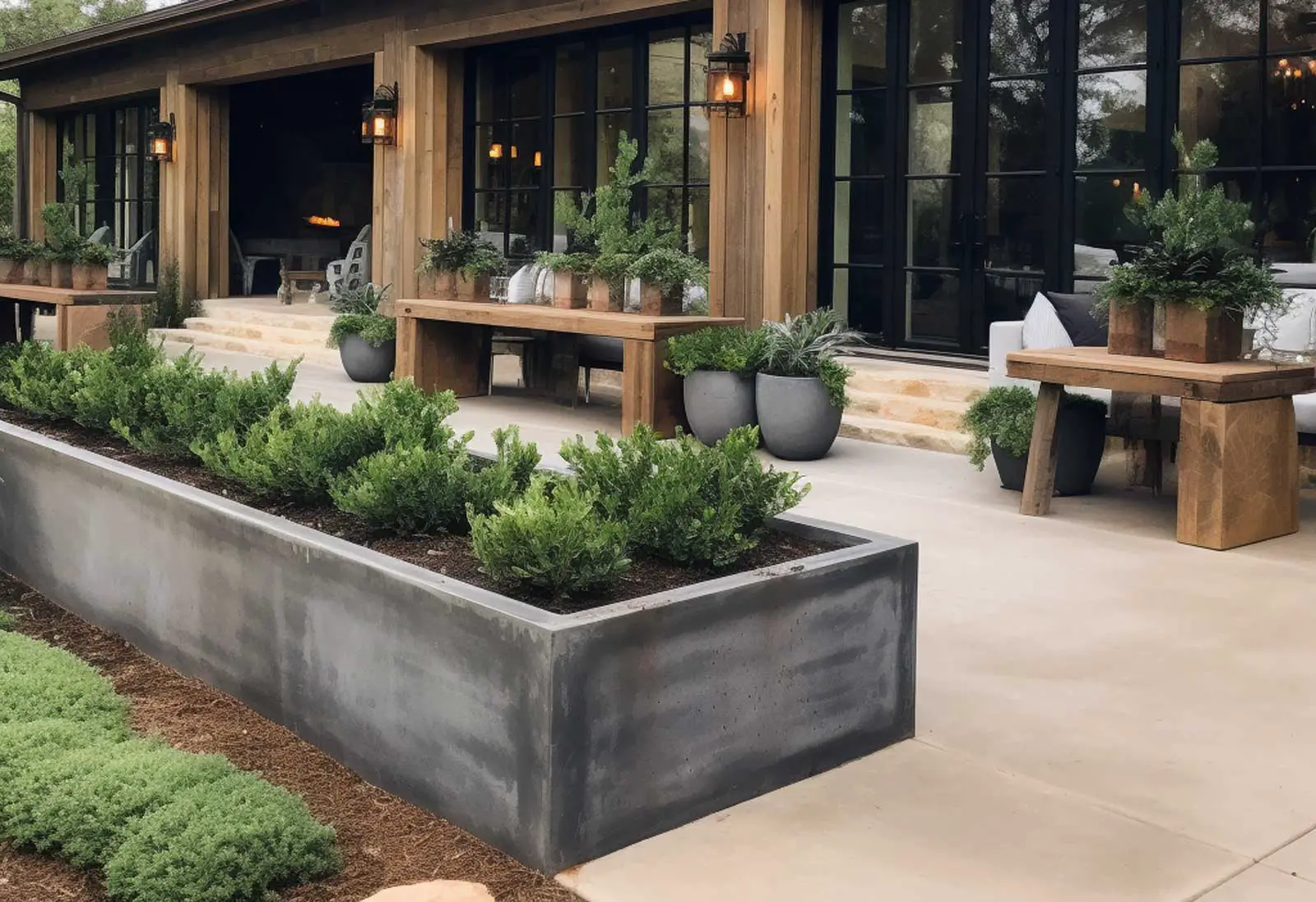
Planter Pizzazz
Concrete planters are a great way to add some greenery to your home’s exterior. They come in a variety of shapes and sizes and can be customized to fit your specific needs. You can even add some color by painting or staining them. Concrete planters are low-maintenance and can withstand the elements, making them a great choice for outdoor use.
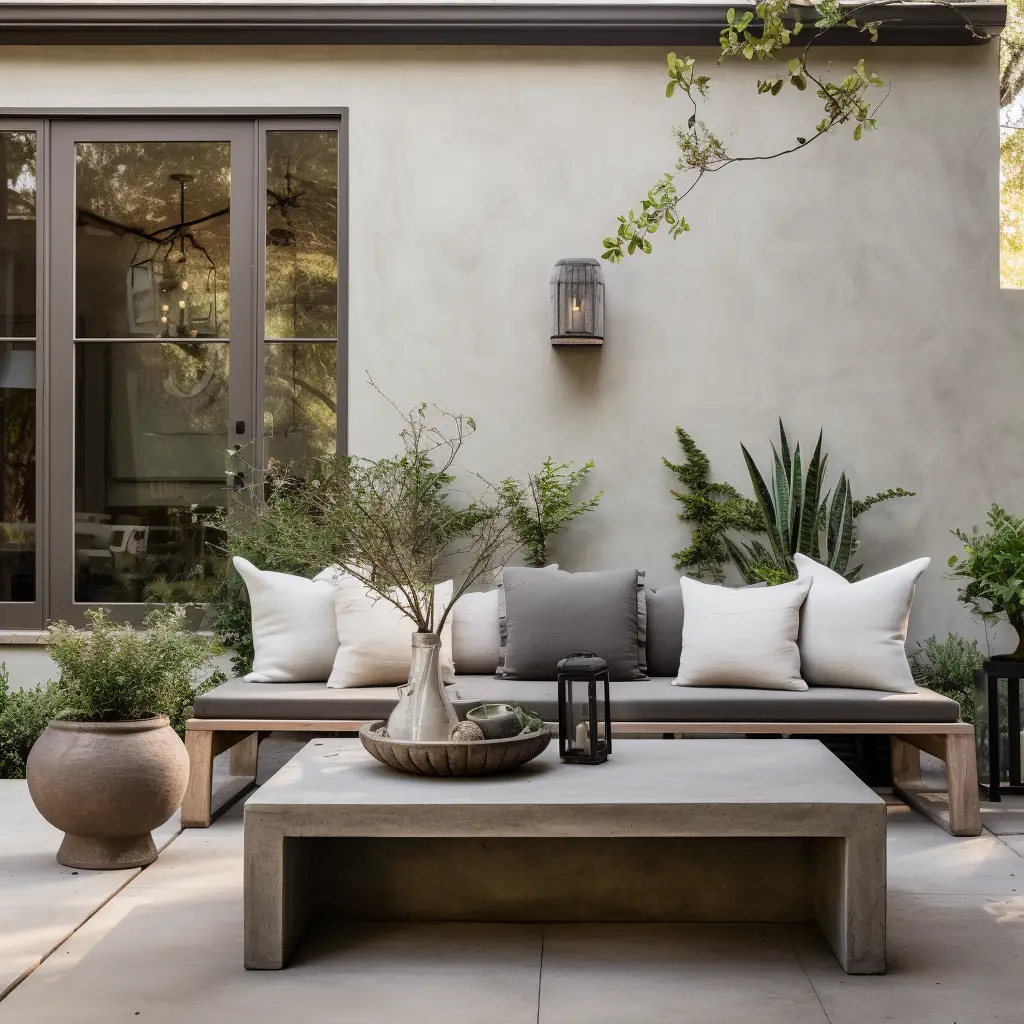
Funky Furniture
Concrete furniture can add a modern and industrial look to your home’s interior. From benches to tables to bookshelves, the possibilities are endless. Concrete furniture is durable and easy to clean, making it a great choice for high-traffic areas. Plus, it can be customized to fit your personal style.
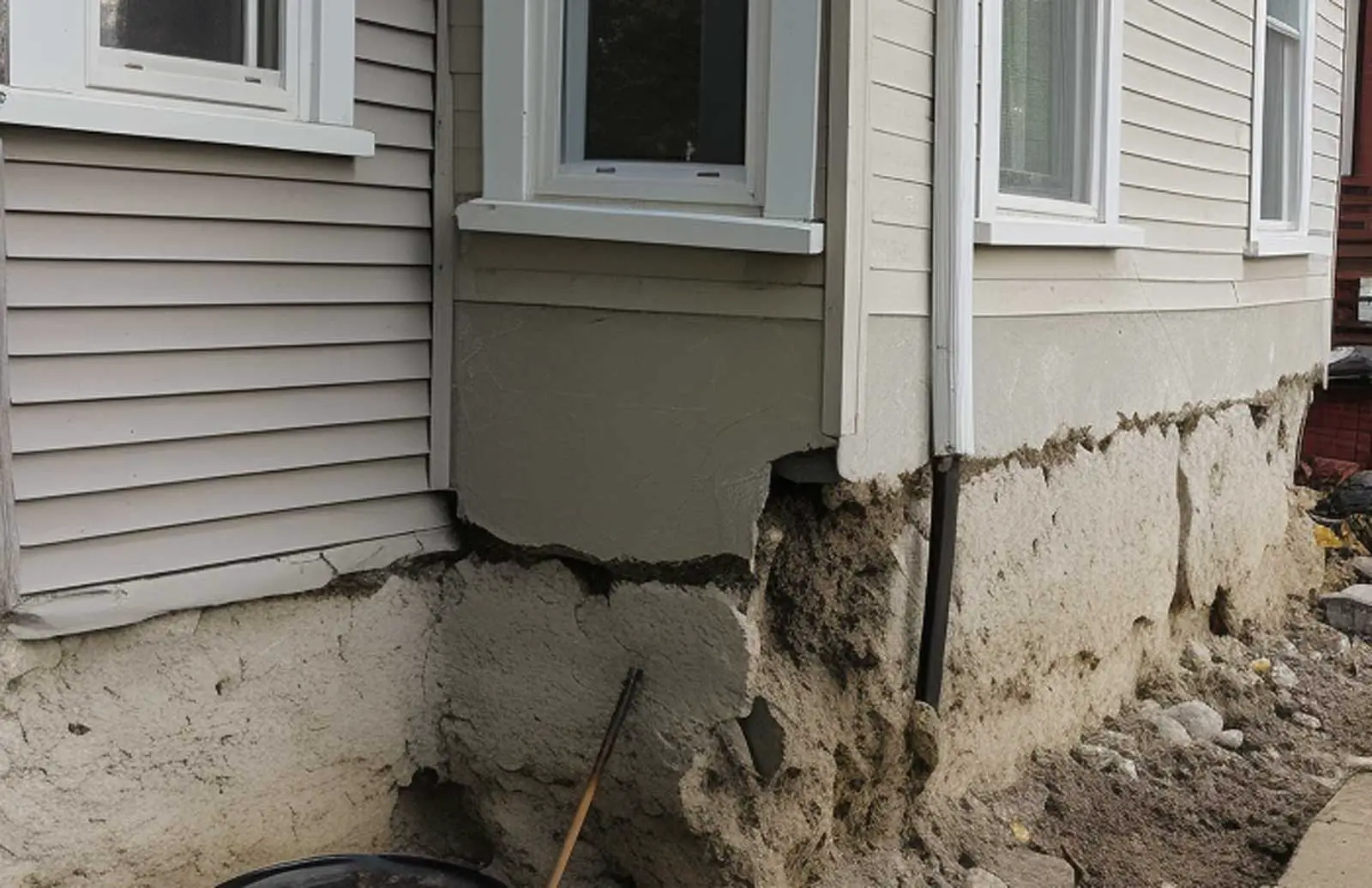
Foundation Fixer-Upper
If you’re looking to add an addition to your home or need to repair a damaged foundation, concrete is the right choice. It’s strong and can withstand the weight of your home. Plus, it’s low-maintenance and can last for decades.
This particular project isn’t necessarily for the newbies because foundation work means serious business when it comes to the structural integrity of your home. You’ll need to account for rebar, what specific type of concrete you need and more.
There’s a big difference between filling in a gap and fixing a foundation. When in doubt, make sure you get with a pro.
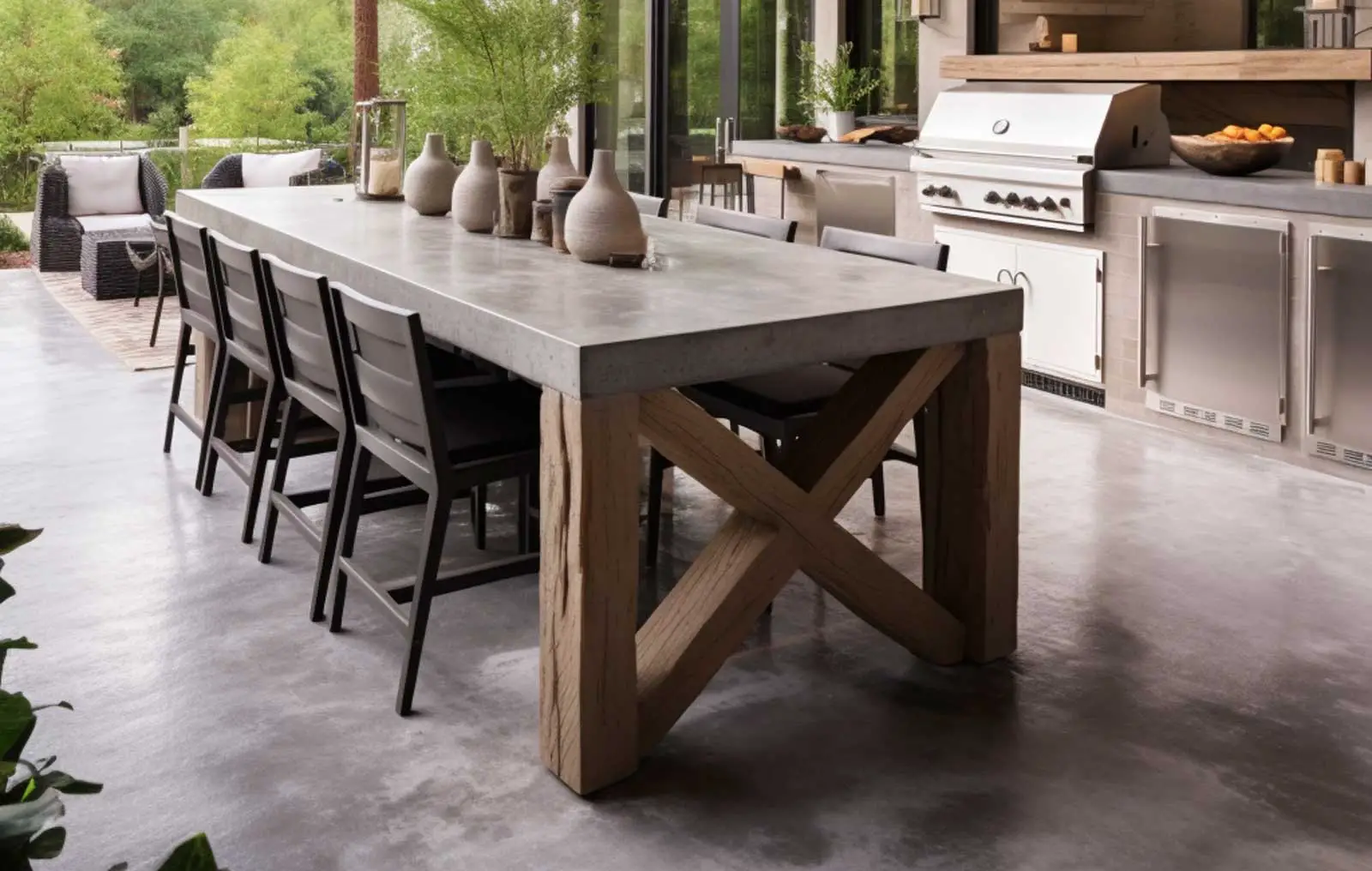
Countertop Chic
Concrete countertops are a great way to add some style to your kitchen or bathroom. They come in a variety of finishes and colors and can be customized to fit your specific needs. Plus, they’re durable and easy to clean, making them a great choice for high-traffic areas.
Concrete countertops can use a lot of concrete, very quickly (don’t ask how I know that). Plus, there are special blends and structural items you need to include like fiber mesh reinforcement, forms, etc. I had a ton of fun doing our concrete counter tops but just know what you’re in for when it comes to finishing them (grinding, sanding and polishing) before you get started.
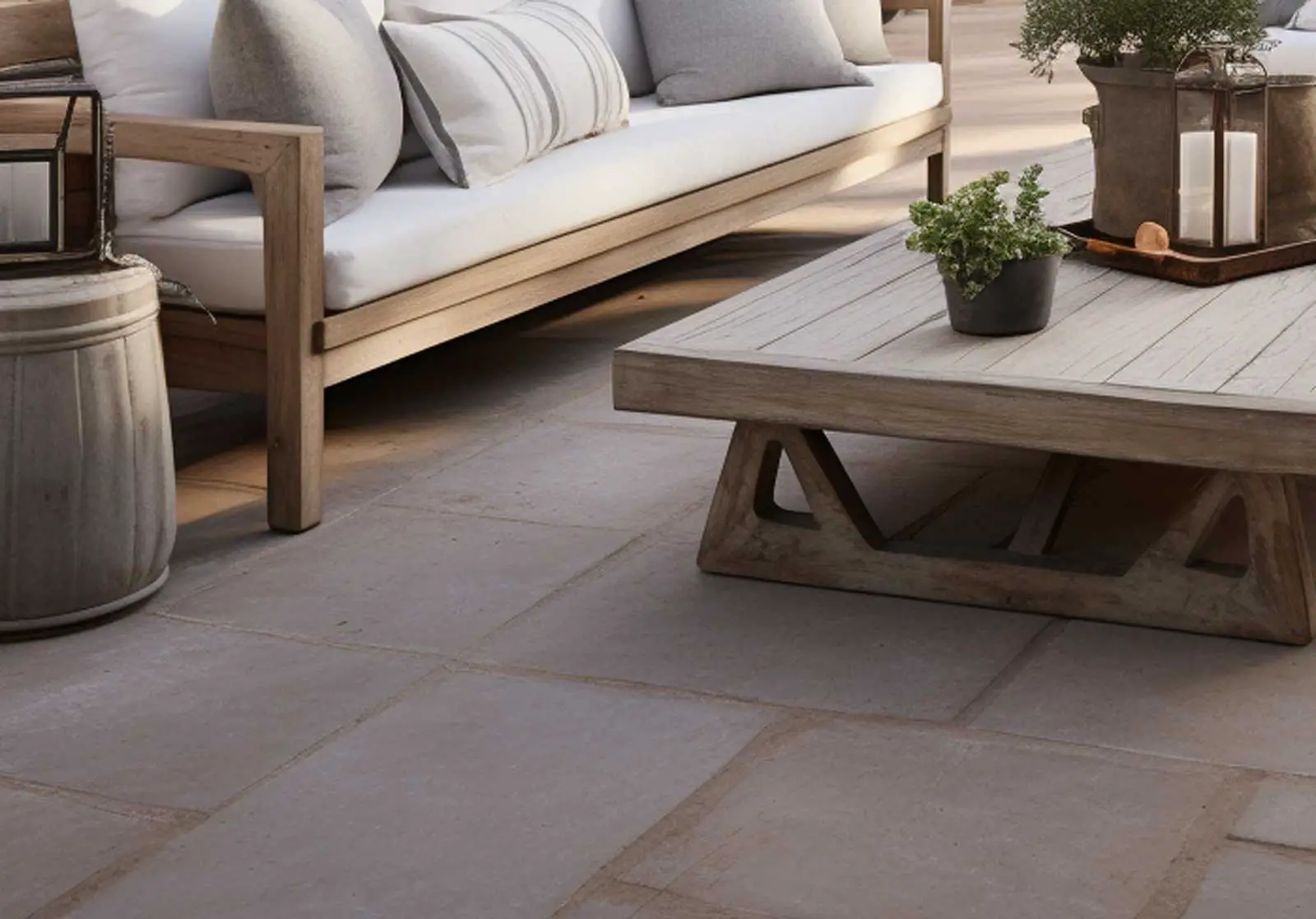
Decked Out
Concrete can be used to create a variety of deck designs. From traditional wood-look to modern and industrial, the possibilities are endless. Plus, concrete decks are low-maintenance and can withstand the elements, making them a great choice for outdoor living areas.
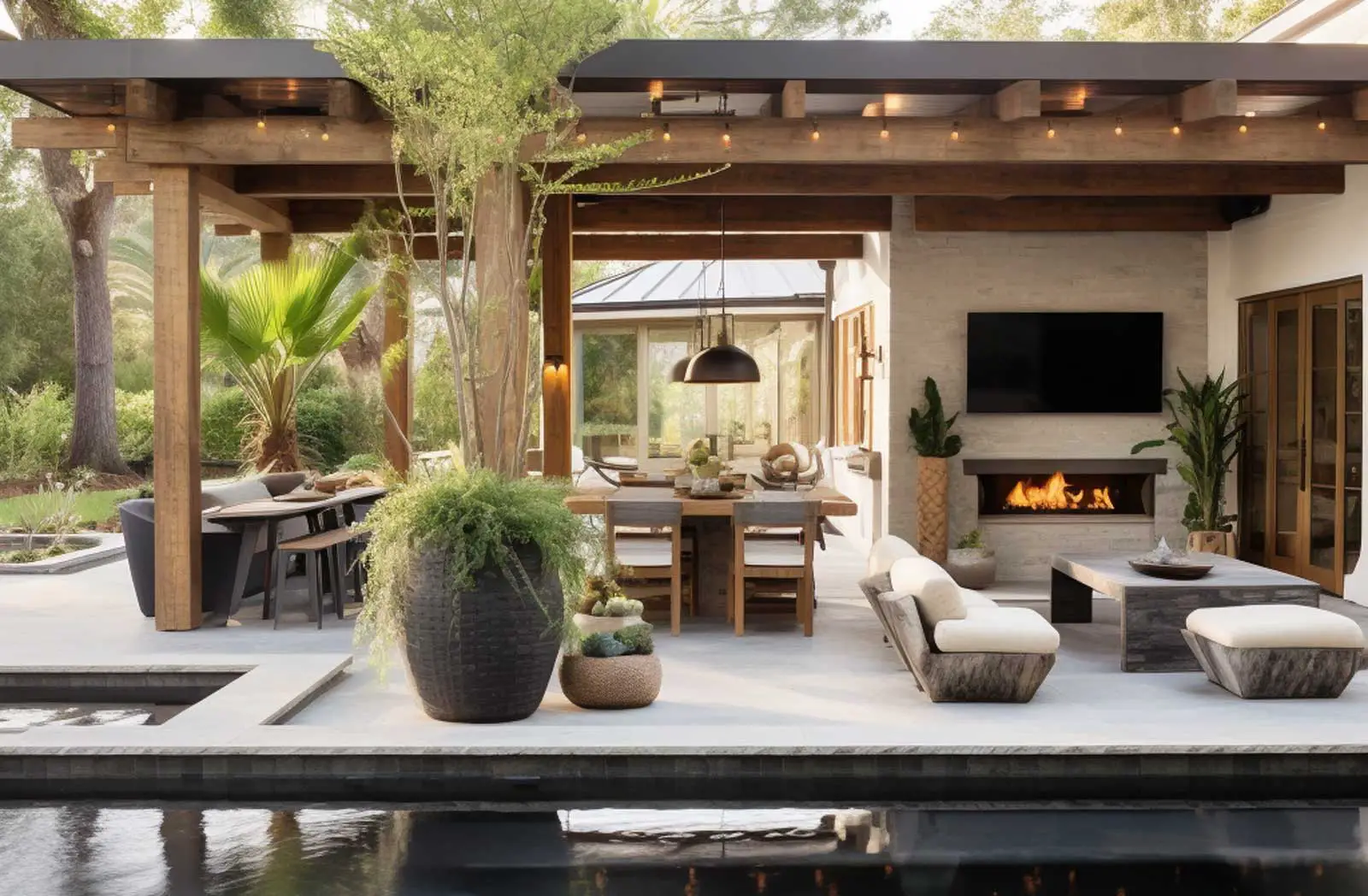
Pool Perfection
Concrete is a popular choice for pool decks and surrounds. It’s durable and slip-resistant, making it a safe choice for wet areas. Plus, it can be customized to fit your personal style.
In my experience, concrete is an incredibly flexible and durable material that can be used for all kinds of projects around the home. Whether you’re looking to add some style to your patio or repair a damaged foundation, concrete is a great choice. Plus, it’s low-maintenance and can last for decades.
Cost and Savings Considerations
When it comes to any home improvement project, cost is always a consideration. You want to make sure that you’re getting the best value for your money. Fortunately, when it comes to concrete projects, there are a few ways to save money.
One of the most significant factors that affect the cost of a concrete project is the amount of concrete needed. This is typically measured in cubic yards. The more concrete you need, the more it will cost. However, you can save money by ordering a larger quantity of concrete. Many concrete suppliers offer discounts for larger orders, so it’s worth checking with your supplier to see if you can get a better price.
Another way to save money on a concrete project is to choose an inexpensive type of concrete. There are many different types of concrete available, each with its own price point. For example, plain concrete is typically less expensive than decorative concrete. If you’re on a tight budget, plain concrete might be the best option for you.
When it comes to purchasing concrete, you have two options: pre-mixed concrete or mixing it yourself. Pre-mixed concrete is more convenient, but it’s also more expensive. If you’re comfortable mixing concrete yourself, you can save a significant amount of money.
In my experience, one of the best ways to save money on a concrete project is to plan ahead. By taking the time to plan your project carefully, you can avoid costly mistakes and make sure that you’re getting the best value for your money.
Installation and Maintenance Tips
Concrete is a versatile and durable material that can be used for a variety of projects. Whether you’re a job site manager or a homeowner, it’s important to understand the basics of concrete installation and maintenance. In this section, we’ll cover everything you need to know to get the most out of your concrete projects.
Mixing and Weight Chart
Before you begin any concrete project, it’s important to know the right mix and weight for the job. The mix and weight of the concrete will depend on the project you’re working on. For example, a sidewalk will require a different mix and weight than a patio.
To determine the right mix and weight for your project, consult a concrete mix and weight chart. These charts will provide you with the information you need to ensure that your concrete project is a success.
Installation Tips
When it comes to installing concrete, there are a few tips you should keep in mind. First, make sure that the area where you’ll be pouring the concrete is properly prepared. This means removing any debris, leveling the area, and compacting the soil.
Next, make sure that you have all the tools you need for the job. This may include a concrete mixer, a trowel, a float, and a screed.
When you’re ready to pour the concrete, make sure that you pour it evenly and avoid overworking the concrete. Overworking the concrete can cause it to lose its strength and durability.
Maintenance Tips
Once your concrete project is complete, it’s important to properly maintain it to ensure its longevity. This may include sealing the concrete to protect it from the elements, cleaning it regularly to prevent staining, and repairing any cracks or damage as soon as it occurs.
In my experience, one of the best ways to maintain your concrete project is to have it professionally inspected and maintained on a regular basis. This will help to identify any potential issues before they become major problems.
By following these installation and maintenance tips, you can ensure that your concrete project is a success and will last for years to come.
Specialized Concrete Applications
Concrete is a versatile building material that can be used in a wide range of projects. From concrete blocks used to build walls to mixed concrete used to create a solid foundation, there are many different applications for this material. However, there are also a number of specialized concrete applications that require a unique approach.
High-Density Concrete
High-density concrete is a type of concrete that is used in applications where weight is a concern. This type of concrete is made with heavy aggregates such as magnetite or barite, which give it a much higher density than traditional concrete. High-density concrete is often used in nuclear power plants, radiation shielding, and counterweights.
Fiber-Reinforced Concrete
Fiber-reinforced concrete is a type of concrete that is reinforced with fibers to increase its strength and durability. The fibers used in this type of concrete can be made from a variety of materials, including steel, glass, and synthetic materials. Fiber-reinforced concrete is often used in applications where high strength and durability are required, such as in building bridges and tunnels.
Self-Consolidating Concrete
Self-consolidating concrete is a type of concrete that is designed to flow and fill in all areas of a formwork without the need for mechanical consolidation. This type of concrete is often used in applications where a smooth finish is desired, such as in architectural concrete and precast concrete products.
Shotcrete
Shotcrete is a type of concrete that is sprayed onto a surface using a high-pressure hose. This type of concrete is often used in applications where a quick and efficient application is needed, such as in the construction of swimming pools and retaining walls. Shotcrete can be reinforced with steel fibers or other materials to increase its strength and durability.
Rapid-Set Concrete
Rapid-set concrete is a type of concrete that sets quickly, often within a few hours. This type of concrete is often used in applications where a quick turnaround time is required, such as in the construction of roads and highways. Rapid-set concrete can be mixed with additives to increase its strength and durability.
Roller-Compacted Concrete
Roller-compacted concrete is a type of concrete that is compacted using a roller rather than being poured into a formwork. This type of concrete is often used in applications where a high-strength, low-maintenance surface is required, such as in the construction of parking lots and industrial flooring.
Stamped Concrete
Stamped concrete is a type of concrete that is stamped with a pattern or texture to resemble other materials such as brick, stone, or wood. This type of concrete is often used in applications where a decorative finish is desired, such as in patios and walkways.
In my experience, specialized concrete applications require a unique approach and careful consideration of the specific requirements of the project. By understanding the different types of specialized concrete and their applications, you can choose the right material for your project and ensure that it meets your needs.
Frequently Asked Questions
Concrete is a versatile and durable building material used in various construction projects. However, before starting a project that requires a pallet load of concrete, you might have some questions in mind. In this section, we will answer some of the frequently asked questions about pallet loads of concrete.
How many bags of 60 lb concrete are on a pallet?
A pallet load of concrete typically contains 56 bags of 60 lb concrete. This means that you will have 3,360 lbs of concrete on a pallet.
How much does a pallet of concrete weigh?
The weight of a pallet of concrete depends on the weight of the bags and the number of bags on the pallet. A pallet load of concrete with 56 bags of 60 lb concrete weighs around 3,360 lbs.
How many yards in a pallet of concrete?
A pallet of concrete contains approximately 0.44 cubic yards of concrete. This is equivalent to 10.5 cubic feet of concrete.
How many bags of concrete on a pallet?
A pallet load of concrete usually contains 56 bags of 60 lb concrete. However, some manufacturers may have different packaging sizes, so it’s best to check the label to confirm the number of bags on a pallet.
How much does a pallet of Quikrete cost?
The cost of a pallet of Quikrete varies depending on the location and the retailer. On average, a pallet load of Quikrete costs around $500 to $600. However, prices may vary depending on the type of Quikrete and the location.
Is it cheaper to mix your own concrete or have it delivered?
Mixing your own concrete can be cheaper than having it delivered, especially if you have access to the necessary equipment and materials. However, if you need a large amount of concrete, it may be more cost-effective to have it delivered. Additionally, having concrete delivered can save you time and labor costs.
In my experience, knowing the answers to these frequently asked questions about pallet loads of concrete can help you plan your project more efficiently. By understanding the weight, quantity, and cost of pallet loads of concrete, you can make informed decisions and ensure that your project is completed successfully.
